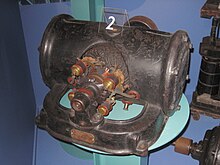Jonas Wenström
Jonas Wenström | |
|---|---|
 | |
| Born | 4 August 1855 |
| Died | 22 December 1893 (aged 38) |
| Nationality | Swedish |
| Occupation(s) | Electrical engineer, inventor |
Jonas Wenström (4 August 1855 in Hällefors – 22 December 1893 in Västerås) was a Swedish engineer and inventor, who in 1890 received a Swedish patent on the same three-phase system independently developed by Mikhail Dolivo-Dobrovolsky.[1] This formed the basis for ASEA (later ABB).[2] The possibility of transferring electrical power from a waterfall at a distance was explored at the Grängesberg mine. A 45 m fall at Hällsjön, Smedjebackens kommun, where a small iron work had been located, was selected. In 1893, a three-phase 9.5 kv system was used to transfer 400 horsepower a distance of 15 km, becoming the first commercial application.[3]

About the invention of electric light, Wenström wrote: "Edison's new invention of electric light: a glowing carbon strip, is the same thing that I discovered a year ago ... If I had his laboratory, and resources, I would have done the same and better ... a graphite strip between two mica plates provide a more effective light than Edison's."[5]
References
- ^ Bergström och Nordlund, Lars. Ellära- Kretsteknik och fältteori. Naturaläromedel. p. 283. ISBN 91-7536-330-5.
- ^ "Jonas Wenström". Nationalencyklopedin (in Swedish). Retrieved 2009-08-08.
- ^ Hjulström, Filip (1940). Elektrifieringens utveckling i Sverige, en ekonomisk-geografisk översikt. [Excerpt taken from YMER 1941, häfte 2.Utgiven av Sällskapet för antropologi och geografi: Meddelande från Upsala univeristets geografiska institution, N:o 29, published by Esselte ab, Stockholm 1941 no. 135205]
- ^ US 292079, "Dynamo Electric Machine", published 15 Jan 1884
- ^ "36:61".
